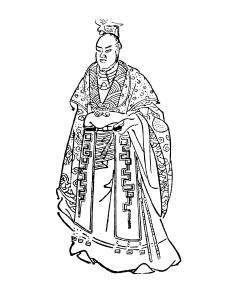Qin Shih Huang's Tomb
Until 1974, thousands of statues remained to be unearthed on the archaeological site at Shaanxi province, where Qin Shih Huang (c. 221–210 B.C.E.), the first unifier of China, was buried. For more than 2,200 years, these statues had been buried together with the Emperor in a massive city surrounded by two walls some twenty meters high (about 65 feet), and punctuated with gates on the northern, southern, western, and eastern sides and square towers at each corner. The excavation near Qin Shih Huang's tomb also uncovered four pits containing a total of nearly 8,000 figures. The soldiers are organized according to the military conventions of the time. In December 1987 the mausoleum was included in the World Heritage List by United Nations Educational, Scientific, and Cultural Organization.
Qin Shih Huang (259–210 B.C.E.) was king of Qin, the largest warrior state in ancient China. One of the most powerful and innovative monarchs in Chinese history, he decreed the building of the Great Wall. He also created many extravagant palaces. Wishing to retain his riches in the afterlife, upon taking the throne he began to build a magnificent underground palace in which he was to be buried. The tomb took some 700,000 workers thirty-eight years to complete. The details of the tomb's scale and contents were recorded in the Shiji, an ancient historical record. Relics excavated from the mausoleum are rich in contents and great in quantity. The king was buried with a symbolic force of life-sized terracotta soldiers, chariots, and

The arrangement of a tomb was not only an important life event but also a religious rite. Qin Shih Huang believed that some people could escape from death, either by living for a very long time or by being reborn in a new form. Therefore, he sent people to find drugs that would grant him longevity. He also prepared replicas of worldly goods to help him in his new life. People believed that if the spirit of the deceased were happy, it would intercede in the spirit world on behalf of its descendants and they would do well.
See also: Chinese Beliefs ; Death System ; Immortality ; Tombs
Bibliography
First Emperor of China, The. Produced by Ching-chih Chen. Santa Monica, CA: Voyager Company, 1991. Videorecording.
Kern, Martin. The Stele Inscriptions of Ch'in Shih-huang: Text and Ritual in Early Chinese Imperial Representation. New Haven, CT: American Oriental Society, 2000.
Lazo, Caroline. The Terra Cotta Army of Emperor Qin. New York: New Discovery Books, 1993.
Li Yu-ning, ed. The First Emperor of China. White Plains, NY: International Arts and Sciences Press, 1975.
MUI HING JUNE MAK
Comment about this article, ask questions, or add new information about this topic: